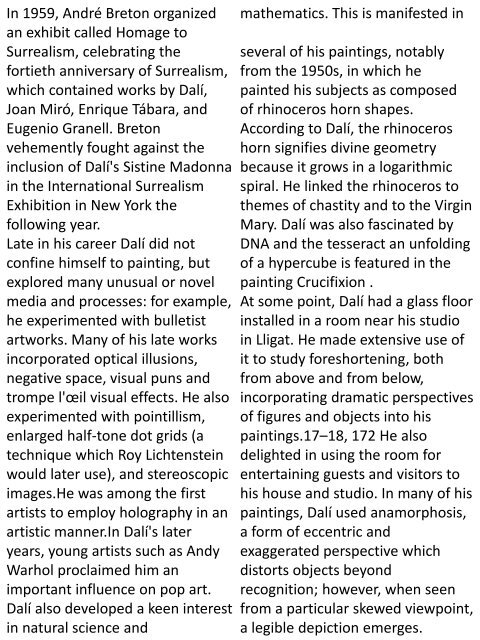Aziz Art July 2018
History of art(west and middle east)- contemporary art ,art ,contemporary art ,art-history of art ,iranian art ,iranian contemporary art ,famous iranian artist ,middle east art ,european art
History of art(west and middle east)- contemporary art ,art ,contemporary art ,art-history of art ,iranian art ,iranian contemporary art ,famous iranian artist ,middle east art ,european art
Create successful ePaper yourself
Turn your PDF publications into a flip-book with our unique Google optimized e-Paper software.
In 1959, André Breton organized<br />
an exhibit called Homage to<br />
Surrealism, celebrating the<br />
fortieth anniversary of Surrealism,<br />
which contained works by Dalí,<br />
Joan Miró, Enrique Tábara, and<br />
Eugenio Granell. Breton<br />
vehemently fought against the<br />
inclusion of Dalí's Sistine Madonna<br />
in the International Surrealism<br />
Exhibition in New York the<br />
following year.<br />
Late in his career Dalí did not<br />
confine himself to painting, but<br />
explored many unusual or novel<br />
media and processes: for example,<br />
he experimented with bulletist<br />
artworks. Many of his late works<br />
incorporated optical illusions,<br />
negative space, visual puns and<br />
trompe l'œil visual effects. He also<br />
experimented with pointillism,<br />
enlarged half-tone dot grids (a<br />
technique which Roy Lichtenstein<br />
would later use), and stereoscopic<br />
images.He was among the first<br />
artists to employ holography in an<br />
artistic manner.In Dalí's later<br />
years, young artists such as Andy<br />
Warhol proclaimed him an<br />
important influence on pop art.<br />
Dalí also developed a keen interest<br />
in natural science and<br />
mathematics. This is manifested in<br />
several of his paintings, notably<br />
from the 1950s, in which he<br />
painted his subjects as composed<br />
of rhinoceros horn shapes.<br />
According to Dalí, the rhinoceros<br />
horn signifies divine geometry<br />
because it grows in a logarithmic<br />
spiral. He linked the rhinoceros to<br />
themes of chastity and to the Virgin<br />
Mary. Dalí was also fascinated by<br />
DNA and the tesseract an unfolding<br />
of a hypercube is featured in the<br />
painting Crucifixion .<br />
At some point, Dalí had a glass floor<br />
installed in a room near his studio<br />
in Lligat. He made extensive use of<br />
it to study foreshortening, both<br />
from above and from below,<br />
incorporating dramatic perspectives<br />
of figures and objects into his<br />
paintings.17–18, 172 He also<br />
delighted in using the room for<br />
entertaining guests and visitors to<br />
his house and studio. In many of his<br />
paintings, Dalí used anamorphosis,<br />
a form of eccentric and<br />
exaggerated perspective which<br />
distorts objects beyond<br />
recognition; however, when seen<br />
from a particular skewed viewpoint,<br />
a legible depiction emerges.


















